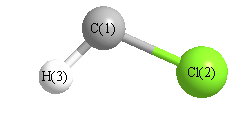Jump to
S2C1
Energy calculated at MP4/aug-cc-pVTZ
| | hartrees |
|---|
| Energy at 0K | -498.234920 |
| Energy at 298.15K | -498.234784 |
| HF Energy | -497.854883 |
| Nuclear repulsion energy | 38.594303 |
The energy at 298.15K was derived from the energy at 0K
and an integrated heat capacity that used the calculated vibrational frequencies.
Geometric Data calculated at MP4/aug-cc-pVTZ
Point Group is Cs
Cartesians (Å)
| Atom |
x (Å) |
y (Å) |
z (Å) |
|---|
| C1 |
0.045 |
1.197 |
0.000 |
| Cl2 |
0.045 |
-0.506 |
0.000 |
| H3 |
-1.043 |
1.425 |
0.000 |
Atom - Atom Distances (Å)
| |
C1 |
Cl2 |
H3 |
| C1 | | 1.7039 | 1.1113 |
Cl2 | 1.7039 | | 2.2163 | H3 | 1.1113 | 2.2163 | |
 More geometry information
More geometry information
Calculated Bond Angles
| atom1 |
atom2 |
atom3 |
angle |
|
atom1 |
atom2 |
atom3 |
angle |
| Cl2 |
C1 |
H3 |
101.790 |
|
Electronic energy levels
Charges, Dipole, Quadrupole and Polarizability
Jump to
S1C1
Energy calculated at MP4/aug-cc-pVTZ
| | hartrees |
|---|
| Energy at 0K | -498.224791 |
| Energy at 298.15K | -498.224643 |
| HF Energy | -497.879246 |
| Nuclear repulsion energy | 38.923111 |
The energy at 298.15K was derived from the energy at 0K
and an integrated heat capacity that used the calculated vibrational frequencies.
Geometric Data calculated at MP4/aug-cc-pVTZ
Point Group is Cs
Cartesians (Å)
| Atom |
x (Å) |
y (Å) |
z (Å) |
|---|
| C1 |
0.036 |
1.155 |
0.000 |
| Cl2 |
0.036 |
-0.513 |
0.000 |
| H3 |
-0.835 |
1.796 |
0.000 |
Atom - Atom Distances (Å)
| |
C1 |
Cl2 |
H3 |
| C1 | | 1.6688 | 1.0821 |
Cl2 | 1.6688 | | 2.4688 | H3 | 1.0821 | 2.4688 | |
 More geometry information
More geometry information
Calculated Bond Angles
| atom1 |
atom2 |
atom3 |
angle |
|
atom1 |
atom2 |
atom3 |
angle |
| Cl2 |
C1 |
H3 |
126.326 |
|
Electronic energy levels
Charges, Dipole, Quadrupole and Polarizability
